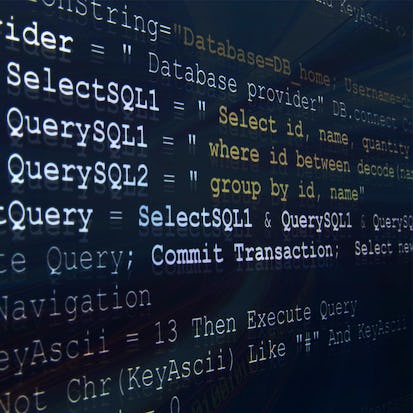- Level Foundation
- المدة
- الطبع بواسطة University of California, Davis
-
Offered by

عن
As data collection has increased exponentially, so has the need for people skilled at using and interacting with data; to be able to think critically, and provide insights to make better decisions and optimize their businesses. This is a data scientist, “part mathematician, part computer scientist, and part trend spotter” (SAS Institute, Inc.). According to Glassdoor, being a data scientist is the best job in America; with a median base salary of $110,000 and thousands of job openings at a time. The skills necessary to be a good data scientist include being able to retrieve and work with data, and to do that you need to be well versed in SQL, the standard language for communicating with database systems. This course is designed to give you a primer in the fundamentals of SQL and working with data so that you can begin analyzing it for data science purposes. You will begin to ask the right questions and come up with good answers to deliver valuable insights for your organization. This course starts with the basics and assumes you do not have any knowledge or skills in SQL. It will build on that foundation and gradually have you write both simple and complex queries to help you select data from tables. You'll start to work with different types of data like strings and numbers and discuss methods to filter and pare down your results. You will create new tables and be able to move data into them. You will learn common operators and how to combine the data. You will use case statements and concepts like data governance and profiling. You will discuss topics on data, and practice using real-world programming assignments. You will interpret the structure, meaning, and relationships in source data and use SQL as a professional to shape your data for targeted analysis purposes. Although we do not have any specific prerequisites or software requirements to take this course, a simple text editor is recommended for the final project. So what are you waiting for? This is your first step in landing a job in the best occupation in the US and soon the world!الوحدات
Erste Schritte
1
Discussions
- Ihre Ziele für diesen Kurs...
1
Videos
- Kurseinführung
Auswählen und Abrufen von Daten mit SQL
2
Assignment
- Lassen Sie uns üben.
- Einfache Select-Abfragen üben
10
Videos
- Moduleinführung
- Was ist SQL Anyway?
- Datenmodelle, Teil 1: Nachdenken über Ihre Daten
- Datenmodelle, Teil 2: Die Entwicklung der Datenmodelle
- Datenmodelle, Teil 3: Relationale Modelle verglichen mit transaktionalen Modellen
- Abrufen von Daten mit einer SELECT-Anweisung
- Erstellen von Tabellen
- Erstellen temporärer Tabellen
- Hinzufügen von Kommentaren zu SQL
- Zusammenfassung
2
Readings
- Übersicht über SQL
- Datenmodellierung und ER-Diagramme
Überprüfung
2
Assignment
- Test zu Modul 1
- Modul 1 – Fragen zur Programmierung
1
Discussions
- Comparing NoSQL and SQL
Filtern, Sortieren und Berechnen von Daten mit SQL
1
Assignment
- Übungstest Modul 2
9
Videos
- Moduleinführung
- Grundlagen des Filterns mit SQL
- Erweiterte Filterung: IN, OR und NOT
- Verwenden von Platzhaltern in SQL
- Sortieren mit ORDER BY
- Mathematische Operationen
- Aggregatfunktionen
- Gruppieren von Daten mit SQL
- Kombination aller Faktoren
1
Readings
- SQL für verschiedene Data-Science-Sprachen
Wiederholung und Übung
2
Assignment
- Test zu Modul 2
- Modul 2 – Programmieraufgabe
Unterabfragen und Verknüpfungen in SQL
1
Assignment
- Übungstest – Abfragen schreiben
10
Videos
- Moduleinführung
- Verwendung von Unterabfragen
- Bewährte Praktiken und Überlegungen zu Unterabfragen
- Verbinden von Tabellen: Eine Einführung
- Kartesische (Kreuz-)Verknüpfungen
- Innere Verknüpfungen
- Aliase und Selbstverknüpfungen
- Erweiterte Verknüpfungen: Linke, rechte und vollständige äußere Verknüpfungen
- Vereinigungen
- Zusammenfassung
2
Readings
- SQL und Python
- „Union“ und „Union All“
Wiederholung und Übung
2
Assignment
- Test zu Modul 3
- Modul 3 – Programmieraufgabe
1
Discussions
- Was werden Sie wohl verwenden?
Ändern und Analysieren von Daten mit SQL
9
Videos
- Moduleinführung
- Working with Text Strings
- Arbeiten mit Datums- und Uhrzeitzeichenfolgen
- Beispiele für Datums- und Uhrzeitzeichenfolgen
- Case-Anweisungen
- Ansicht
- Daten-Governance und Profiling
- Verwenden von SQL für Data Science, Teil 1
- Verwenden von SQL für Data Science, Teil 2
1
Readings
- Weitere SQL-Ressourcen zum Erkunden
Wiederholung und Übung
2
Assignment
- Test zu Modul 4
- Modul 4 – Fragen zur Programmierung
Peer-Review-Aufgabe
1
Peer Review
- Rollenspiel für Data Scientists: Profiling und Analyse des Yelp-Dataset
2
Readings
- Willkommen bei den Peer-Review-Aufgaben!
- Yelp-Dataset-SQL-Lookup
Kurszusammenfassung
1
Discussions
- Wie möchten Sie SQL in Zukunft einsetzen?
1
Videos
- Kurszusammenfassung
Auto Summary
"SQL für Data Science" is a foundational course by Coursera aimed at beginners in data science and AI. Taught by an expert instructor, it covers the basics of SQL, helping learners write queries, work with different data types, and create tables. Through practical assignments and real-world examples, students will gain skills to retrieve and analyze data effectively. The course offers flexible subscription options, making it accessible for those looking to enhance their data science capabilities and pursue a high-demand career.

Sadie St. Lawrence


